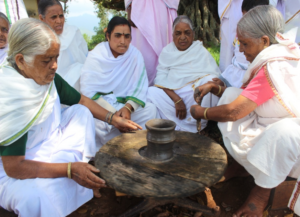 One of the tribes residing in the Nilgiris since time immemorial is the Kotas. Kota women are the only members of the tribe allowed to practice the craft of Kota stone pottery. Kota pottery uses black stone, unlike most other arts that use clay. The products have fine, intricate carvings that will be a beautiful addition to your home. From the extradition of the material to the molding, shaping and firing, everything is done by women of the tribe. Stone pottery products within the tribe are used not only for religious purposes but also as daily life objects for cooking, cleaning, water storage, as utensils, etc. The Kotas have co-existed with the other indigenous communities of the district for centuries. Kotas make all household pottery, daily vessels, oil lamps, clay smoking pipes; also, metal and leather goods and carpentry products.This artistically inclined people with so much of skill and creativity in them, the art Pot making probably stands out as the most exquisite. Pottery making amongst the Kotas is a collective enterprise in which both men and women participate. Men engage in the construction of the wheel and help the women in the digging of clay and firing. Shaping of The pots and padding on the wheel is done entirely by the women. Even though there are no restrictions to the involvement of men in making pots, such instances are rare. A potter a woman never works alone. She has at least one helper who is also skilled but to a lesser degree. is to turn the wheel while the master-potter shapes the pot. The co-potter, it seems always knows when to turn the wheel fast and when to slow it down when, apparently, finer movements are being executed! Common traits of Kota pots are that they are all burnished which means the pots are rubbed with a small round stone before the pots become absolutely dry. Burnishing thus, brings a shine to the surface, giving the pots better texture and longevity. Clay collection during Kota festivals is considered auspicious and the ceremony is extensive. Sounds of trumpets assemble people to the central spot in the village. Men, women and children follow the musicians, who are the first to come out of the village, all heading towards the mud collection place. The priest’s wife begins the digging followed by other women, to symbolize the activity. Finally, ferns are collected to line the heads of the women who will eventually carry the clay back to the village. These pottery items after fine carvings and shaping are burnt to make them ready to use.
One of the tribes residing in the Nilgiris since time immemorial is the Kotas. Kota women are the only members of the tribe allowed to practice the craft of Kota stone pottery. Kota pottery uses black stone, unlike most other arts that use clay. The products have fine, intricate carvings that will be a beautiful addition to your home. From the extradition of the material to the molding, shaping and firing, everything is done by women of the tribe. Stone pottery products within the tribe are used not only for religious purposes but also as daily life objects for cooking, cleaning, water storage, as utensils, etc. The Kotas have co-existed with the other indigenous communities of the district for centuries. Kotas make all household pottery, daily vessels, oil lamps, clay smoking pipes; also, metal and leather goods and carpentry products.This artistically inclined people with so much of skill and creativity in them, the art Pot making probably stands out as the most exquisite. Pottery making amongst the Kotas is a collective enterprise in which both men and women participate. Men engage in the construction of the wheel and help the women in the digging of clay and firing. Shaping of The pots and padding on the wheel is done entirely by the women. Even though there are no restrictions to the involvement of men in making pots, such instances are rare. A potter a woman never works alone. She has at least one helper who is also skilled but to a lesser degree. is to turn the wheel while the master-potter shapes the pot. The co-potter, it seems always knows when to turn the wheel fast and when to slow it down when, apparently, finer movements are being executed! Common traits of Kota pots are that they are all burnished which means the pots are rubbed with a small round stone before the pots become absolutely dry. Burnishing thus, brings a shine to the surface, giving the pots better texture and longevity. Clay collection during Kota festivals is considered auspicious and the ceremony is extensive. Sounds of trumpets assemble people to the central spot in the village. Men, women and children follow the musicians, who are the first to come out of the village, all heading towards the mud collection place. The priest’s wife begins the digging followed by other women, to symbolize the activity. Finally, ferns are collected to line the heads of the women who will eventually carry the clay back to the village. These pottery items after fine carvings and shaping are burnt to make them ready to use.


